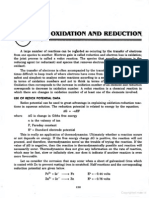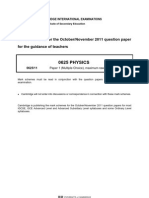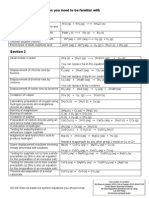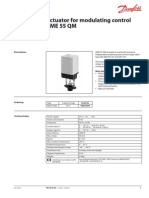Chapter 21 Polymers: Which One of The Following Is Not An Addition Polymer? A Polythene B PVC C Nylon D Poly (Propene)
Chapter 21 Polymers: Which One of The Following Is Not An Addition Polymer? A Polythene B PVC C Nylon D Poly (Propene)
Uploaded by
Neil RichardsonCopyright:
Available Formats
Chapter 21 Polymers: Which One of The Following Is Not An Addition Polymer? A Polythene B PVC C Nylon D Poly (Propene)
Chapter 21 Polymers: Which One of The Following Is Not An Addition Polymer? A Polythene B PVC C Nylon D Poly (Propene)
Uploaded by
Neil RichardsonOriginal Description:
Original Title
Copyright
Available Formats
Share this document
Did you find this document useful?
Is this content inappropriate?
Copyright:
Available Formats
Chapter 21 Polymers: Which One of The Following Is Not An Addition Polymer? A Polythene B PVC C Nylon D Poly (Propene)
Chapter 21 Polymers: Which One of The Following Is Not An Addition Polymer? A Polythene B PVC C Nylon D Poly (Propene)
Uploaded by
Neil RichardsonCopyright:
Available Formats
IGCSE Chemistry Multiple Choice Questions: Chapter 21
Chapter 21 Polymers
21.1
Which one of the following is not an addition polymer?
A polythene
B PVC
C nylon
D poly(propene)
nteracti!e "#ltiple Choice $#estions are a!aila%le on the &de'cel (C)& Chemistry Acti!eBoo* CD
IGCSE Chemistry Multiple Choice Questions: Chapter 21
21.2
A plastic has the following list of #ses+ drainpipes, replacement windows, sheet
flooring, electrical ins#lation- .he plastic is
A poly(chloroethene) / commonly called PVC
B poly(ethene) / commonly called polythene
C poly(propene) / often called polypropylene
D nylon
nteracti!e "#ltiple Choice $#estions are a!aila%le on the &de'cel (C)& Chemistry Acti!eBoo* CD
IGCSE Chemistry Multiple Choice Questions: Chapter 21
21.3
What is the name of the polymer which has the following chain str#ct#re?
A polythene
B poly(propene)
C polystyrene
D poly(chloroethene)
nteracti!e "#ltiple Choice $#estions are a!aila%le on the &de'cel (C)& Chemistry Acti!eBoo* CD
IGCSE Chemistry Multiple Choice Questions: Chapter 21
21.4
PVA (#sed as a gl#e) has the chain str#ct#re+
.he monomer that this is made from is
A 01/C02C0/C1C03
B C022C0/1/C1C03
C C03/C02/1/C1C03
D C0/1/C1C03/C02
nteracti!e "#ltiple Choice $#estions are a!aila%le on the &de'cel (C)& Chemistry Acti!eBoo* CD
IGCSE Chemistry Multiple Choice Questions: Chapter 21
21.5
4ylon56,6 can %e made in the la% %y reacting together the two monomers+
he'anedioyl dichloride+ Cl1CC02C02C02C02C1Cl
1,65diaminohe'ane+ 024C02C02C02C02C02C02402
Which one of the following statements a%o#t this reaction is not true?
A When the monomers com%ine together, 0Cl is lost-
B .his is an e'ample of condensation polymerisation-
C .he str#ct#re of the nylon can %e shown as
D .he str#ct#re of the nylon can %e shown as
nteracti!e "#ltiple Choice $#estions are a!aila%le on the &de'cel (C)& Chemistry Acti!eBoo* CD
IGCSE Chemistry Multiple Choice Questions & ns!ers: Chapter 21
Chapter 21 Polymers
21.1
Which one of the following is not an addition polymer?
A polythene
B PVC
C nylon
D poly(propene)
ns!er: C
Comment
4ylon is a condensation polymer / yo# ha!e to *now that- .he answer is C-
nteracti!e "#ltiple Choice $#estions are a!aila%le on the &de'cel (C)& Chemistry Acti!eBoo* CD
IGCSE Chemistry Multiple Choice Questions & ns!ers: Chapter 21
21.2
A plastic has the following list of #ses+ drainpipes, replacement windows, sheet
flooring, electrical ins#lation- .he plastic is
A poly(chloroethene) / commonly called PVC
B poly(ethene) / commonly called polythene
C poly(propene) / often called polypropylene
D nylon
ns!er:
Comment
.hese are all #ses of PVC / the answer is A-
nteracti!e "#ltiple Choice $#estions are a!aila%le on the &de'cel (C)& Chemistry Acti!eBoo* CD
IGCSE Chemistry Multiple Choice Questions & ns!ers: Chapter 21
21.3
What is the name of the polymer which has the following chain str#ct#re?
A polythene
B poly(propene)
C polystyrene
D poly(chloroethene)
ns!er: "
Comment
7oo* for the repeating #nit- 8o# can 9#st ta*e the first two car%ons in the chain in this
case, %eca#se the ne't ones 9#st repeat the pattern- .his wo#ld come from a
compo#nd with a car%on5car%on do#%le %ond with a C03 gro#p attached to one of
the car%ons- .hat:s propene, and the polymer is poly(propene) / answer B-
nteracti!e "#ltiple Choice $#estions are a!aila%le on the &de'cel (C)& Chemistry Acti!eBoo* CD
IGCSE Chemistry Multiple Choice Questions & ns!ers: Chapter 21
21.4
PVA (#sed as a gl#e) has the chain str#ct#re+
.he monomer that this is made from is
A 01/C02C0/C1C03
B C022C0/1/C1C03
C C03/C02/1/C1C03
D C0/1/C1C03/C02
ns!er: "
Comment
7oo* for the repeating #nit- f yo# ta*e the first two car%on atoms in the chain, that
pattern then repeats itself o!er the rest of the chain-
.he car%ons in the chain came from a car%on5car%on do#%le %ond with a
complicated side gro#p attached- .he compo#nd m#st %e ;5C02C02 or C022C05;,
where ; is the side gro#p- 8o# need to thin* a%o#t the molec#le written %oth ways
aro#nd- 8o# might, for e'ample, 9#st as well ha!e chosen the repeating #nit from the
second and third car%on atom-
f yo# compare this with the answers, B is an e'act match to what yo# ha!e wor*ed
o#t-
nteracti!e "#ltiple Choice $#estions are a!aila%le on the &de'cel (C)& Chemistry Acti!eBoo* CD
IGCSE Chemistry Multiple Choice Questions & ns!ers: Chapter 21
21.5
4ylon56,6 can %e made in the la% %y reacting together the two monomers+
he'anedioyl dichloride+ Cl1CC02C02C02C02C1Cl
1,65diaminohe'ane+ 024C02C02C02C02C02C02402
Which one of the following statements a%o#t this reaction is not true?
A When the monomers com%ine together, 0Cl is lost-
B .his is an e'ample of condensation polymerisation-
C .he str#ct#re of the nylon can %e shown as
D .he str#ct#re of the nylon can %e shown as
ns!er: C
Comment
A is tr#e- .he molec#les lose a hydrogen from the 1,65diaminohe'ane and a chlorine
from the he'anedioyl dichloride each time a %ond is made %etween the two
molec#les-
B is also tr#e- Condensation polymerisation is where lots of small molec#les 9oin #p
to ma*e a %ig one, with the loss of molec#les li*e 0Cl or water in the process-
.hat lea!es yo# to decide which of the two str#ct#res is right- f yo# loo* at the %loc*s
in C, yo# can see that each one is attached directly to a car%on at one end and a
nitrogen at the other- B#t if yo# compare that with the str#ct#res of the molec#les yo#
are starting from, that can:t %e right- .hese ha!e either two car%on5containing gro#ps
at each end or two nitrogen5containing gro#ps-
C m#st %e wrong, %#t D descri%es this e'actly-
nteracti!e "#ltiple Choice $#estions are a!aila%le on the &de'cel (C)& Chemistry Acti!eBoo* CD
You might also like
- BS 07668-2016 PDFDocument26 pagesBS 07668-2016 PDFAsheque IqbalNo ratings yet
- GCE Physics Topic Test 1Document40 pagesGCE Physics Topic Test 1刘奇No ratings yet
- 2018 Singapore-Cambridge A Level H2 Chemistry P2 Suggested Answer Key (9729)Document14 pages2018 Singapore-Cambridge A Level H2 Chemistry P2 Suggested Answer Key (9729)Imagreenbucklegirl SGNo ratings yet
- Gcse Data Work Book Compiled by MR BradfordDocument80 pagesGcse Data Work Book Compiled by MR Bradfordapi-655636980% (1)
- Topic 3 Test Chemistry Year 10Document13 pagesTopic 3 Test Chemistry Year 10Do It Yourself - DIYNo ratings yet
- Elasticity Work SheetDocument6 pagesElasticity Work SheetAnas SaadNo ratings yet
- IGCSE Chemistry Energy ChangesDocument11 pagesIGCSE Chemistry Energy ChangesahmedNo ratings yet
- Learner Guide For O Level PhysicsDocument33 pagesLearner Guide For O Level PhysicsArslan FarooqNo ratings yet
- IGCSE ChemistryDocument25 pagesIGCSE ChemistrygeminisignNo ratings yet
- IGCSE Chemistry Section 5 Lesson 3Document43 pagesIGCSE Chemistry Section 5 Lesson 3Bhawana Singh100% (1)
- Allotropes of CarbonDocument5 pagesAllotropes of CarbonAbhradeep Blogs100% (1)
- Model Textbook of Chemistry For Senior Secodary Schools: January 2006Document499 pagesModel Textbook of Chemistry For Senior Secodary Schools: January 2006I am SheldonNo ratings yet
- Oxidation and ReductionDocument26 pagesOxidation and ReductionSazzad TanimNo ratings yet
- X X X X X: Kwok Tak Seng Catholic Secondary School F.2 Mathematics Chapter 3 - Formulas (Part 2)Document3 pagesX X X X X: Kwok Tak Seng Catholic Secondary School F.2 Mathematics Chapter 3 - Formulas (Part 2)api-3700944No ratings yet
- Chapter 1 Measurement 3E SP WS3 Vernier 2011Document2 pagesChapter 1 Measurement 3E SP WS3 Vernier 2011Chandini JosephNo ratings yet
- Polymers NotesDocument10 pagesPolymers NotesThaarvena RetinaNo ratings yet
- 172 Bonding and Electronegativity - Van Arkel TrianglesDocument4 pages172 Bonding and Electronegativity - Van Arkel TrianglesM DiNo ratings yet
- 2022 O-Level E-Math 4048 AnalysisDocument31 pages2022 O-Level E-Math 4048 AnalysisJong Kook Kim100% (1)
- 0625 w11 Ms 11Document2 pages0625 w11 Ms 11Shrungar BhuvaNo ratings yet
- 1 Lattice Energy and Born-Haber Cycle 1Document31 pages1 Lattice Energy and Born-Haber Cycle 1ashleyjap123No ratings yet
- 2306 WMA11 01 IAL Pure Mathematics P1 October 2023 Pdf1 1 1Document32 pages2306 WMA11 01 IAL Pure Mathematics P1 October 2023 Pdf1 1 1Sandy ZakharyNo ratings yet
- ChemistryDocument22 pagesChemistrySourodip KunduNo ratings yet
- Cambridge IGCSE: CHEMISTRY 0620/02Document16 pagesCambridge IGCSE: CHEMISTRY 0620/02Yu MayNo ratings yet
- Worksheet Acid Bases and SaltsDocument4 pagesWorksheet Acid Bases and SaltswardaNo ratings yet
- Chemistry SSC-I (3rd Set)Document5 pagesChemistry SSC-I (3rd Set)Amaan KareemNo ratings yet
- Brown Chemistry PracticalsDocument26 pagesBrown Chemistry PracticalsSadiaMaryamNo ratings yet
- BearingsDocument15 pagesBearingsJoann NgNo ratings yet
- Cracking AlkanesDocument2 pagesCracking Alkaneskadek_windyNo ratings yet
- WS 5 IG I Chemistry REACTING MASSES AND CHEMICALDocument4 pagesWS 5 IG I Chemistry REACTING MASSES AND CHEMICALRaj MalkanNo ratings yet
- Pre Igcse Revision WorksheetDocument2 pagesPre Igcse Revision WorksheetStage7 CAIENo ratings yet
- Symbol Equations You Need To Be Familiar WithDocument3 pagesSymbol Equations You Need To Be Familiar WithKamrul Alam MasumNo ratings yet
- WS2 IG I Chemistry (1) SEPERATING MIXTURESDocument4 pagesWS2 IG I Chemistry (1) SEPERATING MIXTURESRaj MalkanNo ratings yet
- H2 Jun Holiday Assignment 2013 AnswersDocument12 pagesH2 Jun Holiday Assignment 2013 AnswersKaitlyn HoNo ratings yet
- Olympiad Model Paper 2018Document9 pagesOlympiad Model Paper 2018deeyamullaNo ratings yet
- Gcse Chemistry: Metals & The Reactivity SeriesDocument28 pagesGcse Chemistry: Metals & The Reactivity SeriesShashibhushan Ashok100% (1)
- IB Chem SL and HL Topic 1 To 5 Theory and MCQ Test PaperDocument23 pagesIB Chem SL and HL Topic 1 To 5 Theory and MCQ Test Papermuffi52No ratings yet
- CBSE Sample Papers Class 10 Maths SA II Solved 2Document13 pagesCBSE Sample Papers Class 10 Maths SA II Solved 2gyanpub100% (1)
- Testing For Reducing and Non Reducing Sugars 2ghnvj7Document5 pagesTesting For Reducing and Non Reducing Sugars 2ghnvj7Lij SinclairNo ratings yet
- Basic Electrolysis Calculations: Chemguide - AnswersDocument2 pagesBasic Electrolysis Calculations: Chemguide - AnswersSalem GarrabNo ratings yet
- Science CombinedDocument315 pagesScience CombinedRajkumar MathurNo ratings yet
- Chapter 6 (Electrolysis) Form 4Document9 pagesChapter 6 (Electrolysis) Form 4AliahYusriNo ratings yet
- Electrolysis of BrineDocument5 pagesElectrolysis of BrineMurali SubramaniamNo ratings yet
- 5.electricity and Chemistry PDFDocument15 pages5.electricity and Chemistry PDFHakim Abbas Ali PhalasiyaNo ratings yet
- Dodoma Secondary School: Form Five CBG Home Academic PackageDocument21 pagesDodoma Secondary School: Form Five CBG Home Academic PackageLastschoolkingZNo ratings yet
- Prelim 2 p3 2011 (For Sharing)Document14 pagesPrelim 2 p3 2011 (For Sharing)Yee Kai TanNo ratings yet
- 2022 H1 Chemistry Dec Revision Book - Answer - FinalDocument36 pages2022 H1 Chemistry Dec Revision Book - Answer - Final2022 BALAKRISHNAN ADHITHINo ratings yet
- Siglap Secondary School: Go Forth With Wisdom and CourageDocument9 pagesSiglap Secondary School: Go Forth With Wisdom and CourageLim Kew ChongNo ratings yet
- Cambridge O Level: Chemistry 5070/11Document16 pagesCambridge O Level: Chemistry 5070/11afyNo ratings yet
- 24BSCY101 - QUESTION BANK (CAT-1) - StudentsDocument13 pages24BSCY101 - QUESTION BANK (CAT-1) - StudentsmageshleelavathiNo ratings yet
- Midterm ADocument8 pagesMidterm AJia-shi ChenNo ratings yet
- Mdcat 2011Document6 pagesMdcat 2011abdulmujeebshaikh1No ratings yet
- Module IV QBDocument19 pagesModule IV QBdaniyaaaal69No ratings yet
- Colchester Dominion Lathe-ManualDocument35 pagesColchester Dominion Lathe-ManualTony FitzgeraldNo ratings yet
- Heating Up Curve-Kiln BurnerDocument2 pagesHeating Up Curve-Kiln Burnerclau100% (1)
- Instruction Manual Coating Thickness GaugeDocument16 pagesInstruction Manual Coating Thickness GaugeRaheel ZiaNo ratings yet
- 1.3 Fundamentals of Metal Casting - Fluidity of Molten Metal - Different Types of Casting Process - Defects in Casting - Testing and Inspection of CastingDocument36 pages1.3 Fundamentals of Metal Casting - Fluidity of Molten Metal - Different Types of Casting Process - Defects in Casting - Testing and Inspection of Castingabgi100% (1)
- Year 11 Worksheet AirDocument4 pagesYear 11 Worksheet AirMohamad El MawlaNo ratings yet
- Eti - Ohe - 27 8 84Document7 pagesEti - Ohe - 27 8 84pradeeepgargNo ratings yet
- ST100 Series Complete Manual (06EN003400a)Document54 pagesST100 Series Complete Manual (06EN003400a)negrinNo ratings yet
- PTB Vol 29 PDFDocument133 pagesPTB Vol 29 PDFNovitaNo ratings yet
- MDDSDoc 6730 3.2Document13 pagesMDDSDoc 6730 3.2Welbert PabloNo ratings yet
- 2400-Series CastCatalog Freeman 201405Document12 pages2400-Series CastCatalog Freeman 201405Andi PurwantoNo ratings yet
- Advance SSC Je 2017 NewDocument176 pagesAdvance SSC Je 2017 Newamrit100% (1)
- Modulo 4 DX Excavator (K3 - K5 - T5 Main Pump)Document32 pagesModulo 4 DX Excavator (K3 - K5 - T5 Main Pump)Omar Diaz Segura100% (6)
- Secondary ToolsDocument40 pagesSecondary ToolsOmkar NishadNo ratings yet
- UR W pdf159Document264 pagesUR W pdf159RezaSohrabiNo ratings yet
- Forced Draft Combustion Vs Natural Draft Combustion: December 2017Document10 pagesForced Draft Combustion Vs Natural Draft Combustion: December 2017Suyash KumarNo ratings yet
- Pmma TDSDocument1 pagePmma TDSBilal AhmedNo ratings yet
- Energy Balance:: ReactionDocument7 pagesEnergy Balance:: ReactionHarsh ShahNo ratings yet
- Pipe Spools Fabrication RecordDocument56 pagesPipe Spools Fabrication Recordcmc261185No ratings yet
- Barton Floco Positive Displacement MetersDocument40 pagesBarton Floco Positive Displacement MetersChoirul Imam100% (1)
- A01 185Document70 pagesA01 185jaimeNo ratings yet
- 2002 Seadoo Shop Manual 1Document557 pages2002 Seadoo Shop Manual 1Anthony Windover100% (1)
- Merck: Safety Data SheetDocument6 pagesMerck: Safety Data SheetDiana Lucia MorantesNo ratings yet
- Instruction Manual TW25 (9240Y) POWERPOINT-DishwaherDocument20 pagesInstruction Manual TW25 (9240Y) POWERPOINT-DishwahergreengawNo ratings yet
- 57 Palmstrom On Engineering Geology in NorwayDocument16 pages57 Palmstrom On Engineering Geology in NorwayvkarayanadathNo ratings yet
- 9 Stang Catalog Deluge PDFDocument2 pages9 Stang Catalog Deluge PDFalfreddieick1No ratings yet
- The Screw-Conveyor Vane Design For Piece-Wise ConstructionDocument4 pagesThe Screw-Conveyor Vane Design For Piece-Wise ConstructionVickraman SNo ratings yet
- Sae400 Weld'N Air - DC Arc Welding Power Source and 35 CFM Air CompressorDocument34 pagesSae400 Weld'N Air - DC Arc Welding Power Source and 35 CFM Air CompressormuaadhNo ratings yet
- Minerals in MeghalayaDocument3 pagesMinerals in MeghalayaDilip Gajanan Namjoshi100% (1)
- Actuator For Modulating Control Ame 55 QM: Data SheetDocument4 pagesActuator For Modulating Control Ame 55 QM: Data SheetVin KenNo ratings yet

























































































